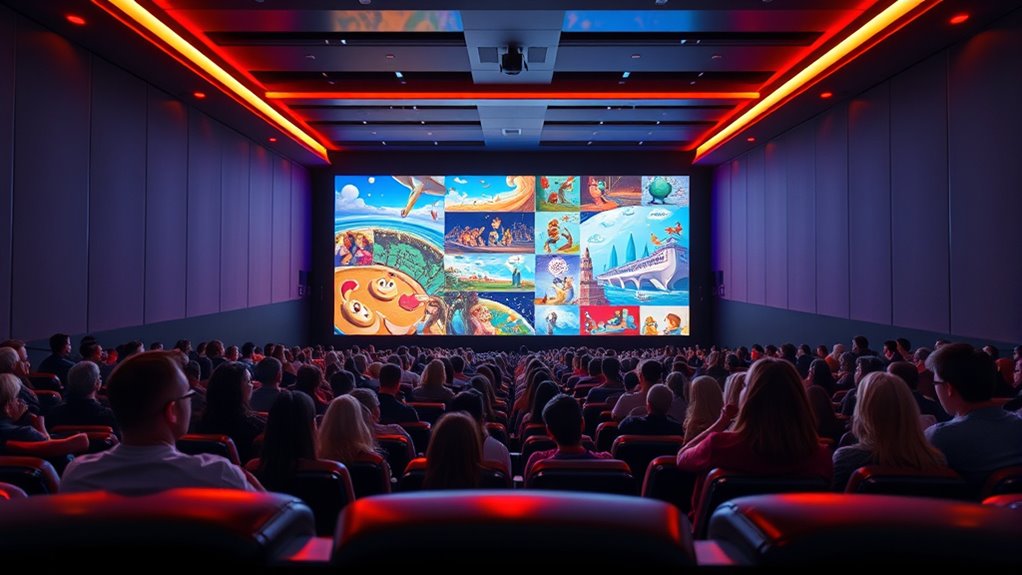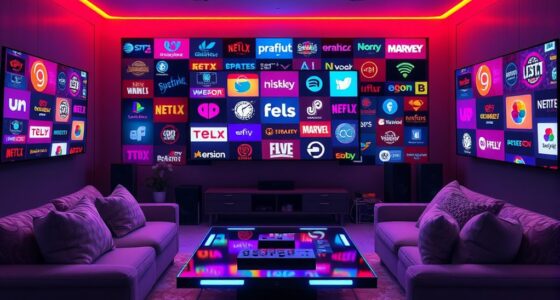Animated anthologies are transforming storytelling by blending diverse artistic styles, cultures, and themes into engaging collections. They let you explore a variety of narratives, from heartfelt to surreal, all within a single experience. This format encourages creative experimentation and showcases animation’s full potential as a powerful communication tool. If you’re curious about how these collections push traditional limits and expand storytelling horizons, there’s even more to discover ahead.
Key Takeaways
- Animated anthologies combine diverse short films, creating a layered and engaging storytelling experience across different styles and themes.
- They showcase cultural, social, and artistic diversity, expanding animation’s role as a powerful medium for complex narratives.
- The format encourages experimentation with techniques, tones, and stories, fostering innovation and inclusivity in animation.
- These collections challenge traditional storytelling boundaries, blending visual innovation with varied emotional and thematic content.
- Animated anthologies serve as cultural movements, broadening appreciation and exploring animation’s full expressive potential.

Have you ever wondered how animated anthologies bring together diverse stories into a single compelling collection? These innovative formats harness the power of visual storytelling to weave multiple narratives into one cohesive experience. Instead of a traditional film or series, animated anthologies serve as a mosaic of short films, each with its unique style, tone, and message. This structure allows creators to explore a wide range of themes and perspectives, giving viewers a richer, more varied cinematic journey. As you watch, you notice how each segment complements or contrasts with the others, creating a layered storytelling experience that’s both engaging and thought-provoking.
Animated anthologies connect diverse stories into a rich, layered visual storytelling experience.
One of the greatest strengths of animated anthologies is their ability to showcase diverse narratives. You might see stories rooted in different cultures, eras, or social issues, all presented through the vibrant lens of animation. This diversity isn’t just in content but also in style—some segments might feature hand-drawn art, while others use digital techniques, stop motion, or experimental visuals. This variety keeps you visually stimulated and underscores the notion that stories can be told in countless ways. It’s a celebration of creativity, where each animator’s unique voice adds to the overall tapestry, making it clear that animation is a versatile medium capable of addressing complex, nuanced topics.
The format also empowers storytellers to experiment without the constraints of a single narrative arc. You can experience a humorous, heartfelt, or surreal story in just a few minutes, which makes the anthology format perfect for exploring new ideas or pushing artistic boundaries. This flexibility invites a broader range of voices, including emerging artists and underrepresented communities, enriching the collection with authentic, diverse perspectives. As a viewer, you’re encouraged to view each story independently, yet see how they connect through themes, motifs, or shared visual language. It’s like entering a gallery of short films, each offering a different window into human experience.
Animated anthologies are revolutionizing storytelling by blending visual innovation with storytelling diversity. They’re not just collections of animated shorts; they’re a dynamic platform for exploring the full potential of animation as a storytelling tool. You get to experience a spectrum of voices and visions, all within a single viewing experience. This format challenges traditional storytelling boundaries and invites you to appreciate the art of animation as a powerful means of communication. You may also notice how visual storytelling techniques enhance the emotional impact of each segment. As you watch, you realize that animated anthologies are more than entertainment—they’re a cultural movement that broadens your understanding of storytelling’s possibilities.
Frequently Asked Questions
How Do Animated Anthologies Influence Traditional Storytelling Techniques?
You see, animated anthologies influence traditional storytelling by highlighting the power of visual storytelling and narrative diversity. They encourage you to experiment with different art styles, themes, and perspectives, making stories more engaging and inclusive. By showcasing varied narratives within a single collection, they push you to think beyond conventional formats and embrace innovation, ultimately enriching your storytelling toolkit and inspiring new ways to captivate your audience.
What Are the Biggest Challenges in Producing Animated Anthology Series?
You’ll face challenges like managing budget constraints, which can limit animation quality and episode scope. Maintaining creative consistency across diverse stories and styles is also tough, requiring careful planning and strong oversight. Balancing these factors while coordinating multiple directors and writers demands organization and flexibility. Ultimately, overcoming these obstacles guarantees your anthology series stays engaging, cohesive, and visually compelling for viewers.
How Do Animation Styles Vary Across Different Anthology Episodes?
You’ll notice animation styles vary widely across anthology episodes, reflecting diverse visual style variations. These differences often stem from cultural influences, allowing each story to have a unique aesthetic that enhances its message. By embracing these variations, you create a richer, more immersive experience for viewers. This approach highlights the creativity and versatility of animation, making each episode stand out with its distinct look influenced by different cultural backgrounds.
What Audience Demographics Are Most Attracted to Animated Anthologies?
You might find that animated anthologies attract diverse audiences, especially teen demographics and international viewers. Coincidentally, these shows often blend universal themes with unique cultural stories, appealing broadly. As a result, you see a mix of young viewers seeking innovative storytelling and global audiences craving relatable content. Your interest aligns with how creators target varied demographics, making animated anthologies a versatile and engaging medium across age groups and countries.
How Can Animated Anthologies Impact Future Media and Entertainment Trends?
You can see that animated anthologies will shape future media by promoting interactive storytelling and crossing cultural narratives. These formats encourage audience engagement and offer diverse perspectives, making entertainment more inclusive and innovative. As you follow these trends, you’ll notice creators blending styles and stories across cultures, pushing boundaries and inspiring new genres. This evolution fosters deeper connections with viewers and expands the possibilities of storytelling in the digital age.
Conclusion
So, next time you binge an animated anthology, remember—you’re not just watching cartoons; you’re experiencing the future of storytelling. Who needs boring old novels or tedious movies when a few minutes of animated brilliance can challenge your worldview? Embrace the chaos, the artistry, and the quirky brilliance. After all, in a world full of endless content, animated anthologies prove that sometimes, the shortest stories leave the biggest impressions—if you’re clever enough to catch them.








